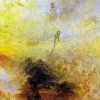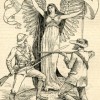
Linda M. Shires, “Color Theory—Charles Lock Eastlake’s 1840 Translation of Johann Wolfgang von Goethe’s Zur Farbenlehre (Theory of Colours)”
The nineteenth century witnessed major developments in color theory, pigment manufacturing, and painting techniques. In 1840, Charles Lock Eastlake—painter, art scholar, and collector—translated Goethe’s 1810 Zur Farbenlehre or Theory of Colours as a handbook and a history, with his own erudite notes, to aid British painters. The volume aimed to offer nineteenth-century artists a deeper education in color than Royal Academy training, which still emphasized imitation of old masters with instruction in composition and line. Eastlake also aimed to restore Goethe’s Aristotelian emphasis on the eye’s perception of color. A focus of debate among scientists and artists, the anti-Newtonian Theory of Colours seriously engaged painters as different in style as J. M. W. Turner and Holman Hunt, both of whom were fascinated by color and nature as seen by the eye. Moreover, Eastlake’s learned notes remained unrivaled for their detailed knowledge of Aristotelian natural science and optics, early technical treatises on painting, and specific Renaissance paintings. Charles Lock Eastlake, a growing authority in the art world of London, went on to be knighted (1850), elected President of the Royal Academy (1850), and appointed the first Director of the National Gallery of Art (1855).

Jo Briggs, “The Second Boer War, 1899-1902: Anti-Imperialism and European Visual Culture”
The Second Boer War, part of the “Scramble for Africa” among European powers, was fought from 1899 and 1902 in what is now South Africa between British Imperial forces and the Transvaal Republic and Orange Free State. The war occurred during the period of so-called New Imperialism (ca. 1880 to 1914) characterized by rising nationalism, racism, Social Darwinism, and genocidal thinking. Occurring roughly in the middle of this period, the Second Boer War became the focal point for a variety of hopes, anxieties, politics, and ideologies. An examination of periodicals created specifically to protest against the war shows that the conflict resonated within diverse local contexts, revealing the complex interplay between global events and local politics.
